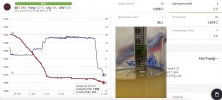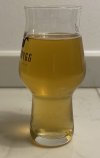Jeg har brygget Czech Pilsner/Lager en del år og bruker følgende infusjonsmeskesjema.
Innmesk: 55C
Steg1: 62C
Steg2: 68C
Jeg har en OG på 1052 og ender normalt opp med FG på 1012.
Jeg bruker wlp830 som vel er den samme som w-34/70.
Første gang jeg brygget en Czech Pilsner var i 2009/2010. Jeg re-kulturerte da gjær fra en Bernard som jeg hadde med hjem fra Tsjekkia. En forholdsvis fersk flaske så prosessen gikk greit.
Ellers foreslår jeg at du også kontakter
http://www.unetickypivovar.cz/ for informasjon om malt, gjær, etc. Dette er en av de nyere mikrobryggeriene som etter min mening lager en av de bedre moderne Tsjekkiske lagerne. Jeg var i kontakt med dem for en del år siden og de var veldig imøtekommende selv på engelsk.
Jeg har en gammel artikkel fra Brewing Techniques om Pilsner Urquell. Artikkelen er fra 1997 så mye er sikkert forandret siden da, men den gir en innsikt i hvordan Pilsner Urquell brygget like etter at landet ble fritt for Kommunismen.
Her er meskesjemaet de brukte da:
Triple-decoction mashing: Pilsner Urquell's mash is performed in 200-hL (170-bbl) vessels and follows the same triple-decoction method used for the past 75 years (18). Thick portions of the mash are drawn off at three different times over the course of more than four hours. Each portion, or decoction, is heated to saccharification temperature, then boiled briefly, and finally returned to the main mash vessel to step up the main mash's temperature. The mash begins with cold water stirred into the grains; hot water is added to bring the temperature to 95 °F (35 °C) for an acid rest. (According to the brewery's quality control manager, Pavel Prucha, the water-to-grain ratio is 1.85 L to 1 kg.) The first decoction raises the temperature to around 127 °F (53 °C) to break down the larger proteins; the second addition raises the mash temperature to 143 °F (62 °C) for starch conversion; and the third brings the temperature to about 163 °F (73 °C) for mash-out (18).
Boiling the mash during decoction breaks down the protein matrix that surrounds the starch, making it more accessible to starch-degrading enzymes in the malt (20), which may offset the fact that the malt is not fully modified. The multistage decoction also helps to adjust the mash pH in a way the water's natural ions cannot (9). The resulting Bohemian Pilseners are a little bit darker (Pilsner Urquell is about 4 °L) and have a slightly stronger and more complex hop character than their German Pils counterparts, which are generally brewed using a double decoction mash schedule (9,20). The Urquell that is exported has a starting gravity of 12 °P (1.048 S.G.).





